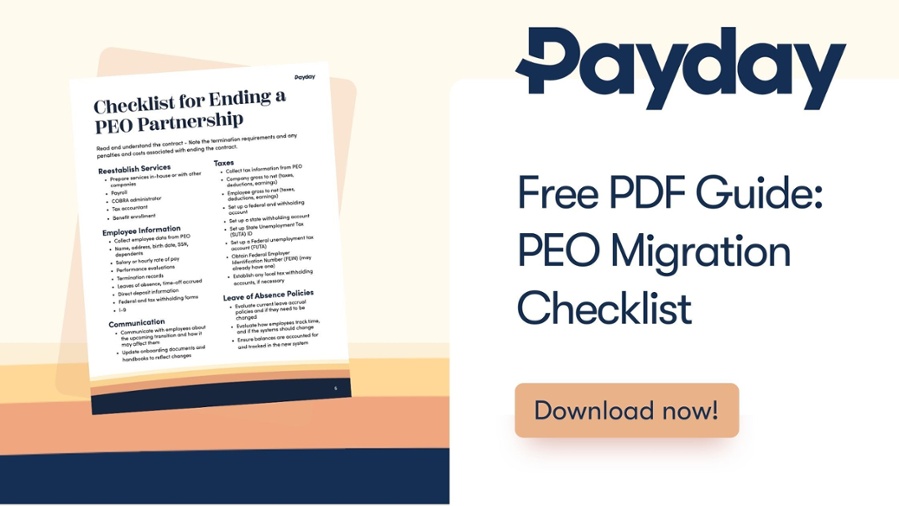Before we unpack the advantages and disadvantages of hiring a PEO, a contextualized definition will go a long way. Many small businesses opt to hire a PEO (Professional Employment Organization) to “inherit” a wide array of administrative and human resources responsibilities that exceed the capacity of their in-house staff. Say, for instance, that your small business’ human resources staff amounts to a DOO (Department of One).
In this case and others, a PEO might adopt responsibilities like payroll administration, workers compensation administration, compliance assistance, benefits management and recruiting and hiring. Regarding this last point, we encourage you to explore our recent article on “Why PEOs Often Slow Down the Hiring Process” which details the practical and company-cultural impacts of outsourcing this responsibility.
In addition to the HR and administrative work they offer, PEOs, technically speaking, are invited by small businesses to become the professional employer of their employees. This means that a small business that collaborates with a PEO, transfers some or all of its legal and financial responsibilities/liabilities to the PEO, whose federal employer identification number (FEIN) is used to report the small business’ wages. This can lead to other ancillary benefits like access to reduced rate benefit options.
Potential Downsides of Hiring a PEO
In spite of the apparent value of a PEO partnership for small businesses, it’s important to consider some of the potential downsides. Fundamentally, working with a PEO means entering a co-employer arrangement where a perceived “third party” (the PEO) is enmeshed in many important aspects of business operations. Here are some potential concerns:
- Resistance from Employees – Even if (in an ideal situation) your HR “department of one” is relieved by the support of a PEO, it’s possible that other employees will resist or even resent the PEO’s role in hiring practices, employee training/evaluation, compliance management, and other unanticipated processes.
- Deterioration of Company Culture – By partnering with a PEO, a small business is – to some degree – fracturing its sense of a unified company culture where important human resources and administrative conversations/decisions are made by those they know and trust. Importantly, without PEO involvement, staff feel like meaningful contributors to the decision-making process. With PEO involvement, these same processes can seem exclusionary or depersonalized.
- Diminished Control Over Vital Processes, Institutional Knowledge, and Security – When “outsourcing” HR or administrative duties to a PEO, a small business loses much of its influence over hiring processes; collecting and analyzing institutional knowledge and data; ensuring comfort and familiarity between staff and HR; and ensuring that security matches company preferences.
Although PEO partnership can help small businesses with compliance issues, provide information on new regulations, and alleviate HR “overload,” there are considerable downsides that may eclipse these benefits. It’s most common for issues to arise in the areas of communications, customer support, and employee wellness. Simply put, it’s essential to remember that a PEO is never fully or exclusively integrated into the operations of your small business; they have their own internal challenges, other clients, and separately defined priorities. Even among well-run PEOs, “third party” operational issues could impact your own business at inopportune times – when you most need the supportive services of your PEO.
If you’re considering hiring a PEO, it’s crucial to begin by speaking with your employees and staff to gauge their attitudes on the prospective partnership. The introduction of a PEO could potentially impact an employee’s job duties, benefits, or sense of cultural cohesion within the company. These and other issues must be considered before making an informed decision. Also, be sure to consider that transitioning out of a PEO partnership can be challenging, particularly when services/roles that were consolidated among the PEO must be redistributed to individual employees.
Fortunately, if you’re already working with a PEO and would like to transition out of the partnership (with minimal headaches), we can help. Start by checking out our recent article on “How to Smoothly Transition Away From Your PEO.” Also, if you’re not already aware, we offer a free PEO Migration Checklist that can help you determine the ideal strategy for ending the partnership and re-allocating the services previously adopted by your PEO.
Whether you’re considering a PEO or already working with one, consider that there’s a viable alternative. Understanding which HR tools your company needs can be a confusing process, but Payday Payroll can work closely with you to identify which services best fit your organization’s unique profile and needs. Our Compliance, Payroll, and HR solutions are cost-effective and scalable to meet your specific business goals.
If you’re interested in affordably addressing your administrative and HR needs without compromising company culture, please contact us today to get started. We’re eager to help your business grow and evolve.


